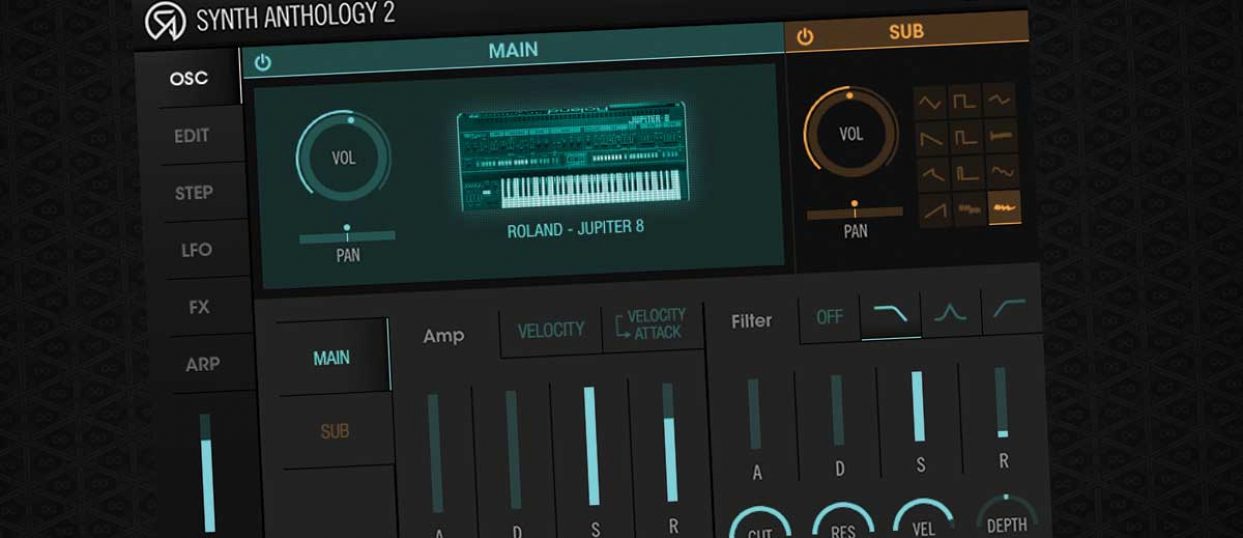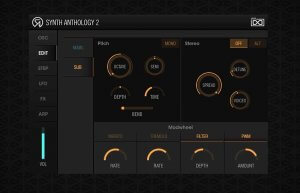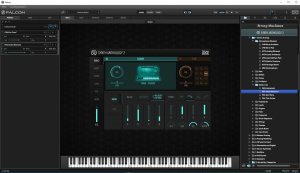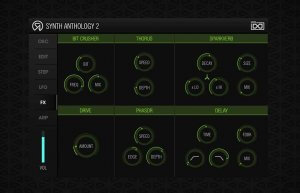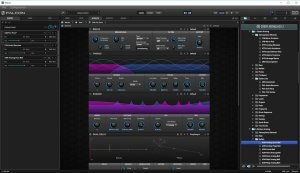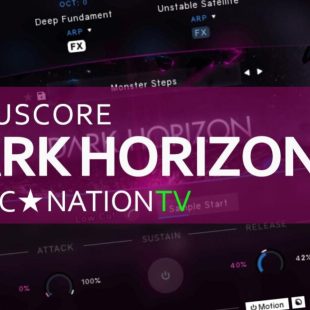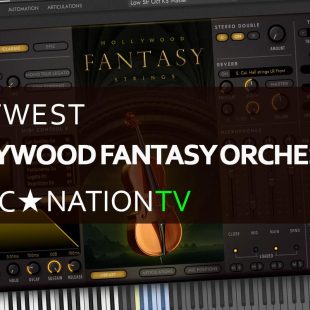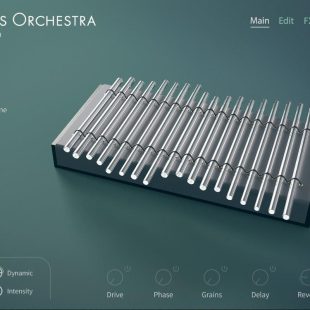UVI Synth Anthology 2 – No Limitations
What happens when you trim all the fat away and reduce a synthesizer down to its purest form? Synth Anthology 2 offers an endless array of possibilities…if you think a little outside the box.
Updated September 2017
Synth Anthology 2 is a synthesizer collection library for UVI Falcon and the free UVI Workstation player, both either free-standing instruments or VST plugins for your DAW. UVI should be well known if you have any degree of interest in vintage synthesis, offering an array of extremely detailed sampled instrument libraries using their own proprietary Falcon/Workstation platform. In particular, the outstanding Vintage Vault bundle features over 100 modelled synths and drum machines that are a must for any aficionado.
Synth Anthology 2 offers a unique control interface that largely removes the complicated nature of synthesis, offering a patch-focused library with a set of controls anybody with basic synthesis knowledge will be at home with. You get a selection of 77 classic and modern synthesizer models with over 2500 unique patches to start with.
The GUI is broken down into 6 tabs, each divided between two synth oscillators – a Main and a second phase distortion sub-oscillator, coloured bluey/green and orange respectively. Enabling an effect or process is a simple matter of clicking the title to illuminate it.
The first tab ‘Osc’ contains the main and sub-oscillator controls. Each has ADSR controls, velocity on/off, amp and filter ADSR, plus you get a choice between three filter shapes (highpass, lowpass and band), with your traditional cutoff, resonance, velocity and depth controls. In addition, the sub-engine allows a further 12 wave-shape variations choices.
The ‘Edit’ tab features typical pitch, width and mod-wheel controls for each oscillator. The ‘Step’ tab allows you to modulate the volume, cutoff, rez and drive with an interesting stepped bars style interface. ‘ARP’ features a simple dual arpeggiator and finally ‘LFO’ and ‘FX’ tabs are fairly self-explanatory, again all using the same global controls for each engine. The ‘FX’ tab contains a good selection of UVI’s high-end processing engines Thorus and SparkVerb, with a bit crusher, distortion, phaser and delay included.
Nothing too challenging to understand for a beginner, and everything is well laid out and fairly simple to navigate. After a short time, the instrument is second nature and you will want to start experimenting with movement and layering to achieve richer sounds.
Included synths are:
- Access: Virus C
- Akai: AX80
- Alesis: Andromeda, Fusion
- ARP: Chroma Polaris, ARP Odyssey, Quadra
- Casio: CZ-1, VZ-1
- Clavia: NordLead
- Dave Smith: Prophet 6
- Elka EK44: Synthex
- Emu: Emax, Emulator 2
- Ensoniq ESQ-M, Fizmo, SQ80, VFX
- Fairlight: CMI IIx
- Formenta: Polivoks
- Kawai: K3, K4R, K5000
- Korg: DS8, DSS1, DW8000, Minilogue, MS20, M1, PS-3200, Triton, Wavestation
- Mellotron: M400
- M-Memory, M-Mini, M-Polymoog, M-Source, M-37
- NED: Synclavier 2
- Novation: Basstation 2, Nova, Ultranova
- Oberheim: Matrix 6, OB6, OB-X, Xpander
- OSC: OSCar
- PPG: Wave 2.3
- RLD: D-Fifty, JD800, J 60, J 106, Jup 4, Jup 8, JX8P, RLD 3o3, VP330
- RSF: Kobol
- SCI: Prophet 5, Prophet VS
- Seiko: DS301
- Siel: DK80 • Studio Electronics: ATC, Boomstar 5089
- Yamaha: AN1X, CS-80, CS20m, DX7, DX100, FS1R, SY77, SY22
- Vermona: Tiracon 6V
- Waldorf: Microwave XT, Pulse, Q
You can think of Synth Anthology 2 as ‘synthesis easy mode, in that the controls for each of the included synth models share the same interface, so no mountain of manuals to pour over, thankfully because the downloadable manual is nothing more than a patch list and reinforcement of the same information you get when you run your mouse over any of the controls. While this could technically be called a rompler, there’s way more to it than just sample playback.
Road Test
So a well-rounded, dual-oscillator instrument with easy controls and great sounds. But the real magic happens when you start layering instruments. Thanks to the very light CPU load and shared interface controls, it’s extremely easy to layer two or (many) more as multi’s devices, creating monster synth walls of sound. In the UVI Workstation software, you’re limited to only four layers, whereas within the Falcon platform, the sky’s the limit. You can set individual pan, volume and pitch for each layer, plus an absolutely mind-numbing array of extra synth controls within the Falcon UI – with quite literally endless possibilities.
The overall sound is excellent, if somewhat too polished – analogue fans will miss the hiss and noise associated with hardware synths. Also, with a combination of the built-in FXs and layering of instruments, it’s easy to create other-worldly patches that are so far removed from the original hardware unit it’s not even fair to call them emulations anymore.
The presets included are excellent, though the 2500+ make finding the right sound somewhat tedious. The patch library is separated out by synth structure (ie classic analogue, FM, Wavetable, additive etc) plus a duplicated ‘categories’ folder where the patches are further separated by sound type (bass, lead, pad, strings etc). However, finding that ‘sound in your head’ is difficult due to the nature of the patch structure. This is more a ‘wade through patches until something pops up you can use’ approach. If you a very familiar with the characteristics of the various synth included you could start your search with a little more insight, but largely it’s a matter of learning the sounds and remembering the best patches – unfortunately, there is no way to mark or highlight your favourites.
Unlike a typical synth emulation, you don’t have anywhere near the same level of onboard control. There’s no modular cabling, matrix editor or multi-oscillator patching here – just your basic ADSR and modulation controls. Each patch is set, you can’t completely redial a sound from scratch or anything like that. The focus is set squarely on presets and then mucking with the built-in LFO and ARP controls to create unique modulations.
And while on paper this might sound a little limiting, in reality, it’s actually flexible and creative. You’re forced to think outside the box a little, the limitations force you to bring in more modulation and layers to form sounds. Of course, you could always layer multiple VST instruments in the past, but the thought of having to understand and program complicated synths often relegated that idea to the bin.
Overall the sound is outstanding, hyped and very clean. I own a couple of the synths included (Juno 106 and Yamaha TG77) and I don’t remember them being as big sounding as this. No doubt a lot of the credit goes to the FX section, but a lot has to be said for the excellent source recorded material, clearly a lot of time has been spent to ensure the highest quality.
CPU overheads are very low, in the sub-10% for each patch on our test system, and up to 12-15% for holding a chord on a complex patch. Even layering up a 5 patch monster with modulations and FX galore didn’t push too hard on the resources, and I never encountered any staggering.
Conclusions
Sometimes I’m reluctant to use a particular synth because it’s basically too taxing for my brain when all I want is a decent-sounding lead or pad. Though there are some fantastic synths sampled here, as well as a few interesting rarities, there is also a tonal balance between them all – they work well together as multis.
A perfect partner for Falcon, Synth Anthology 2 patches beg to be layered and affected with the extended synth controls it offers. As a cool bonus, when you buy Falcon from the UVI store you get a $100 USD/Euro voucher for the purchase of any sound banks – so if you can stretch your credit card just a little bit more at checkout for both you will have a spectacular setup.
The included step, arp and FX controls push the sound towards a very contemporary result, which might not sit well with vintage purists looking for analogue offerings. Hardcore synth-heads might also grumble at the limited controls on offer, but they won’t complain about the sound quality.
For $149 USD Synth Anthology 2 is an absolute steal. There is no doubt this is one of the best value synth preset libraries available right now, and when teamed with Falcon arguably the best sounding too. While there are plenty of other excellent synth collections out there (including UVI’s own Vintage Vault), nothing comes anywhere near as easy to use as this.
If you already own a few in-depth synths, now might be a perfect time to give your brain a break and try easy-mode synthesis at its best.
Full details on UVI’s website right here www.uvi.net
Test Machine Specs
Core i5-6500 3.20 Ghz 16gig RAM. The library is installed on a secondary 7200 drive.
Propellerhead Reason 9.5
Windows 10, 64bit.
Focusrite Scarlett 214 Interface
Roland Jupiter 80 and Akai MPD218 controllers
Presonus Eris E44 and Aventone Mixcubes monitors
Shure SRH940 headphones

